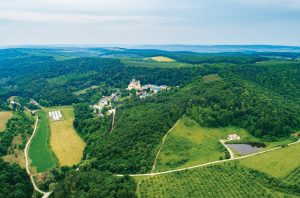In partnership with Wines of Moldova
Amid the ebbs and flows of wine trends, truly revolutionary wine countries can easily fly under the radar as they steadily evolve. One such country is the Republic of Moldova, which has seen an exciting transformation in recent years, driven by innovation, entrepreneurship and historical rediscovery.
Located in the far east of Europe, with Romania to the west and Ukraine to the north, east and south, Moldova is at the very epicentre of the renaissance of Eastern European wine. The transformation of the country’s wine industry has brought impressive advances in both the technical and stylistic standards that make Moldovan wine special. At the core of this revolution is an entrepreneurially-minded community of stakeholders – growers, producers, restaurants and exporters – that has championed a focus on quality wines and state-of-the-art infrastructure, for both wine production and tourism.
Natural wealth
It’s not hard to see why Moldova, sitting roughly on the same latitude as Bordeaux and with a continental climate close to that of Burgundy, is so well suited to winemaking. An average year sees 310-320 days of sunshine and 450-550 mm of rainfall, while the country’s regions vary in elevation but are largely low and hilly. Biodiversity also plays an important role, with vast forests harbouring native flora and fauna and ensuring balanced ecosystems – with a direct impact on the health and natural resilience of the vines.
Topography, biodiversity and geology all contribute to the diversity and quality of Moldovan wines, creating an intricate patchwork of terroirs. From black chernozem to iron-rich loams and heavy clays, the range of soils yields wines of very different characters and reveals different expressions of each variety. Varied climatic influences, meanwhile, bring further diversity and stronger strength of character: while mostly continental, Moldova sees moderating Mediterranean influences in the southwest, as well as cooling effects from Black Sea breezes – factors shaping its distinct mesoclimates.

There’s no shortage of winemakers taking advantage of these natural assets and intrinsic potential for quality – with a total of over 128,000 ha under vine, Moldova has the highest density of vineyards of any country in the world. In recent years the country has seen an exciting transformation, revolutionising its wine production through ever bigger investment and quality and technology, but also through a deeper understanding of its viticultural history, terroirs and grape varieties.
The rediscovery of indigenous grapes, as well as the exploration of the country’s ability to deliver world-class examples of international varieties, has taken place hand-in-hand with a better understanding of Moldova’s landscape and the implementation of viticultural best practices. By exploring the many ways in which visitors can experience the landscape, wine and food of a fascinating country where diverse cultural influences – from Latin to Slavik, Turkish to Balkan, and Catholic to Orthodox – have converged, Moldova’s winemakers are acting as ambassadors of a uniquely rich culture.
A history of tenacity
Viticulture has a long history in Moldova: archaeological evidence indicates it predates even the arrival of ancient Greek colonists in the area, and Herodotus reports a wine-drinking culture among its residents in the mid- 5th century BCE. Over the centuries, the fortunes of winemakers fluctuated as the territory changed hands, with a peak in the 15th century followed by a lull under the Ottoman empire; but by 1914 Bessarabia (largely within modern-day Moldova) was the top source of wine for the Russian Empire.
As the industry rebuilt itself after the phylloxera blight and devastation of the Second World War, the Soviet market became the focus. After independence, Russia remained the primary market accounting for over 80% of exports by 2006, when an embargo imposed by the Russian Federation – used as means of political leverage – halted trade of Moldovan wines. Through all these challenges, the country’s wine industry has survived by marrying tradition with innovation, in varieties planted, winemaking practices and styles. This historical resilience underpins the drive and determination that has led Moldovan wine to where it is now.

In recent decades the country’s wine industry has evolved rapidly. In 2013, a structural reform of the sector set new – and transformational – quality, traceability, regulatory and marketing standards. Observers have commented that Moldova resembles a New World country in its openness of approach, and is distinguishing itself on the international market by pairing its historic indigenous varieties with modern winemaking practices to produce high-quality wines of unique, authentic character. It’s this meeting of new and old, of innovation and tradition, that is increasingly bringing Moldova to the attention of consumers, buyers and sommeliers.
These efforts are now being widely recognised: in the last five years, Moldovan wines won over 6000 medals at prestigious international competitions including the Decanter World Wine Awards, Mundus Vini, Concours Mondial du Bruxelles and the International Wine Challenge. These successes are a testament to the work and insight of all the producers and entrepreneurs who, facing many challenges but with a relentless belief in the quality and potential of Moldovan wine, have made it the exciting wine destination it is today.
Discover more about wines of Moldova
Connect on
Facebook | Instagram








